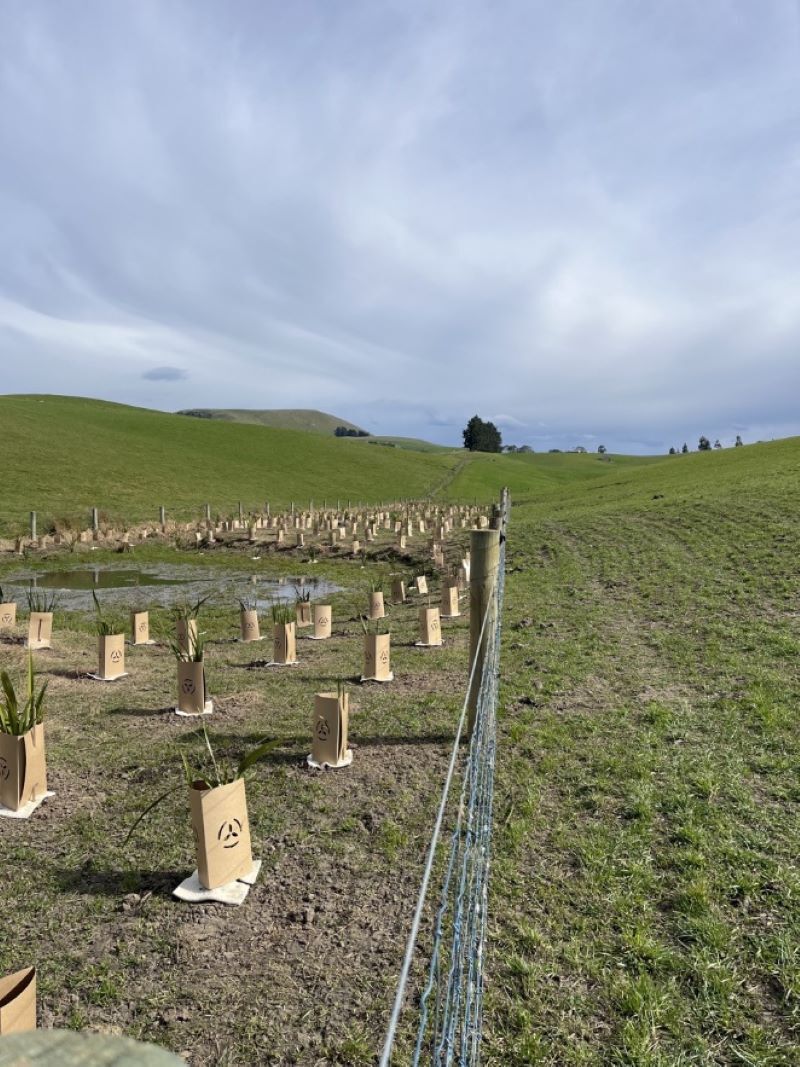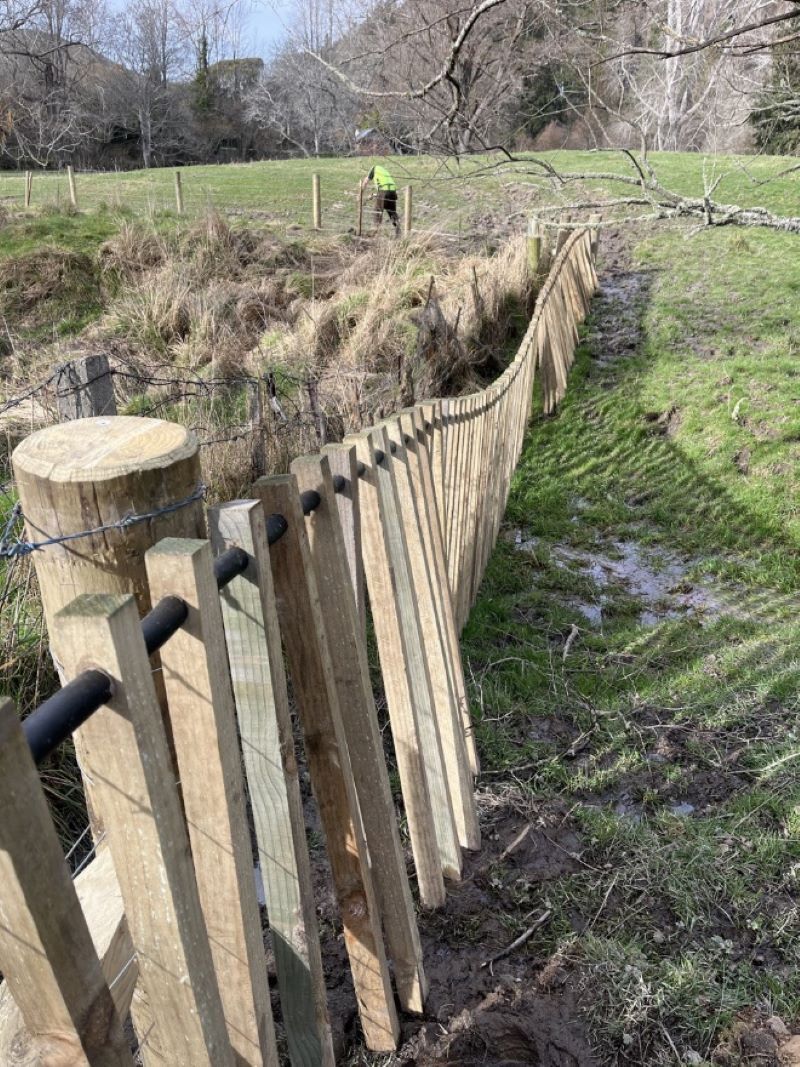Toitū Te Hakapupu - Pleasant River restoration project taking shape
Staff Reporter
14 February 2024, 11:48 PM
 The community hard at work during a planting day in September 2023. Photos: Otago Regional Council
The community hard at work during a planting day in September 2023. Photos: Otago Regional CouncilA catchment action plan is expected to be ready soon for the next phase of the Toitū Te Hakapupu – Pleasant River restoration project in East Otago – which has already received strong community and rūnaka support.
Toitū Te Hakapupu is a four-year partnership project between Otago Regional Council (ORC) and Kāti Huirapa Rūnaka ki Puketeraki, focussed on improving the health of the wai (water) in East Otago's Pleasant River catchment, encompassing Pleasant River, Trotters Creek, Watkin Creek, and the coastal estuary.
The project, which is now well underway, is funded by ORC and the Ministry for the Environment’s (MfE) Essential Freshwater Fund through the Government’s Jobs for Nature programme (to create jobs while enhancing nature).
The $5.2m restoration project consists of $786,000 of funding from ORC, supported by nearly $4m from MfE, as well as a contribution, by landowners, of 25% of the total work being completed on their land.
“This is a journey to create a catchment action plan that will inspire the community to sustain the awa (river) and we’re excited to partner with Kāti Huirapa Rūnaka ki Puketeraki and work in collaboration with East Otago Catchment Group and the community,” ORC project delivery specialist Melanie White said.
“We’re close to having a first draft of the catchment action plan ready to share with the community early in 2024.”
The action plan will take the form of a “living document” with a survey to collect further thoughts and ideas around the plan, she says.
Three of the project’s three main actions are:
- To develop a Catchment Action Plan to help guide the community at the completion of the project, to continue to improve water quality and biodiversity in the catchment for years to come
- Construction of up to 60 kilometres of fencing to exclude stock from waterways; and
- Planting of up to 100,000 native plants to reduce sediment loss into the rivers and to increase biodiversity.
Work on the project to date
Several hui and workshops have been held over the past 18 months to introduce landowners and other community members to the project, outline what it seeks to achieve, and ask the community for ideas and
input to prioritise issues and actions.
“There has been great interest and attendance from the local rūnaka and community to come and share their thoughts and feedback,” Melanie said.
Opportunities were identified for scientific monitoring, planting days and surveys and the feedback at each of the sessions has also helped guide the project team in their efforts.
Two such workshops were structured around the development of the action plan for Te Hakapupu/Pleasant River.
The first was to identify issues and challenges the catchment faced, what is important for management of the catchment, and what the community thought the catchment should be like for future generations.
The second workshop built upon this vision for the catchment and focussed on identifying actions that would help address the problems identified while also meeting values and goals for the catchment.
Locations for these actions were also discussed and lists made of groups and organisations that could help achieve them.

One of the community meetings held in Waikouaiti last year
Work well underway
“While the greater community have been very forthcoming with ideas and thoughts, helping with community monitoring and exploring the science behind this project, landowners have been equally supportive and keen to do their part to improve the health of Te Hakapupu,” Melanie said.
In 2022, a lot of the project team’s time was spent contacting landowners, community, suppliers, spreading the word on the project and its goals, and building strong relationships with project partner Kāti Huirapa
Rūnaka ki Puketeraki, East Otago Catchment Group and technical specialist, Ahikā Consulting.
“During 2023 a lot of planning came to fruition, with work undertaken on 13 properties in the catchment this year.
“About 4.5km of fencing has been constructed and over 22,000 trees planted, thanks to the Aukaha planting team and the community,” she said.
Local landowner Daryl Watson said he is “really pleased” with how everything has gone so far.
“The project staff have been very easy to work with and I’m excited to see greener and more biodiverse areas on our farm. As well as cleaner water and the repopulation of kōura/crayfish in our waterways for the next generations of my family to enjoy.”
Melanie said the project team is excited at the prospect of doing even more this year.
There is interest from 17 landowners so far for work on their property, and the project team is hoping to kick off the planting season earlier - either in May or June.
“We’re blown away by how much the community has supported Toitū Te Hakapupu and there seem to be more and more landowners coming on board to do their bit all the time,” she said.


Fencing and planting efforts in the catchment, including a floating fence (above) which allows water and debris to pass during a flood.
Planting days
A community planting day was held in September, on landowner Steven Foote’s property at the corner of Jefferis Road and State Highway 1. This event kicked off the 2023 planting season and saw some of the first plants go in the ground as part of the project.
More than 50 people attended and the community planted 1200 natives, contributing to the improvement of water quality in the area.
On 11 October 2023, more than 30 year 5 and 6 students from Karitāne and Waikouaiti schools in East Otago took part in another Planting Day just North of Waikouaiti.
A regionally significant wetland had been fenced off on a piece of private land to protect it from stock and the children helped plant over 100 native trees along the riverbank on this property.
They also learnt about the health of the river from one of the ORC catchment advisors, Jack Mathieson, did some water quality testing, and saw some taoka (treasured) species in the river
including kōura (crayfish) and tuna (eels).
The children also took part in a cultural health discussion with local rūnaka representative Julia Rata-Te Raki.
The plants have been grown and supplied by Kāti Huirapa Rūnaka ki Puketeraki’s community nursery and Ribbonwood Nurseries in Dunedin, and include species such as coprosma, carex, harakeke (flax) and tī kōuka (cabbage tree).
Cultural monitoring
The whānau from Kāti Huirapa Rūnaka ki Puketeraki have also been out in the catchment this year to undertake the first round of cultural health monitoring for the project.
This monitoring will allow mana whenua to establish a baseline of the current health of the awa, identify areas where restoration can achieve the greatest improvement in cultural health, and track changes in the catchment over time.
Six sites across the catchment, in addition to the three sites that have already been monitored in Watkin and Trotters Creeks through our work with Ngāi Tahu Forestry, will be looked at.
Results from this monitoring will be available soon.
Water quality monitoring
Ahikā Consulting is leading the technical work to assess water quality and support the rūnaka and community in setting visions and goals for the catchment and are behind the development of the catchment action plan with support from the community.
The process of environmental DNA (eDNA) analysis helps to measure the current water quality of the catchment by identifying what species are present in the catchment.
In December 2022, eDNA analysis was performed at six sites by ORC, assisted by East Otago Catchment Group.
Ahikā Consulting have summarised these findings (pictured below) as:
- Ten species of freshwater fish and seven estuarine/marine species were detected in the catchment.
- Three of the freshwater types are considered threatened. Four are considered mahika kai species.
- There is no evidence yet of the non-migratory types of galaxiids, which are becoming very rare throughout the country. If they do appear in future rounds of monitoring, options for their protection will be considered, as trout will eat them and compete with them for habitat.
Forestry action plan
A Forestry Working Group has also been created to guide the development of a Forestry Action Plan, with the objective to have agreed sustainable forestry management practices that reduce the impacts
of forest management on water quality, riparian margins and identified catchment values.

Forestry (pictured) is the predominant land use in Te Hakapupu catchment, so the plan is an important component of the overall restoration project.
The first draft of a Forestry Action Plan will be ready to share with the community soon. You can find out more about the project on the Otago Regional Council website:


